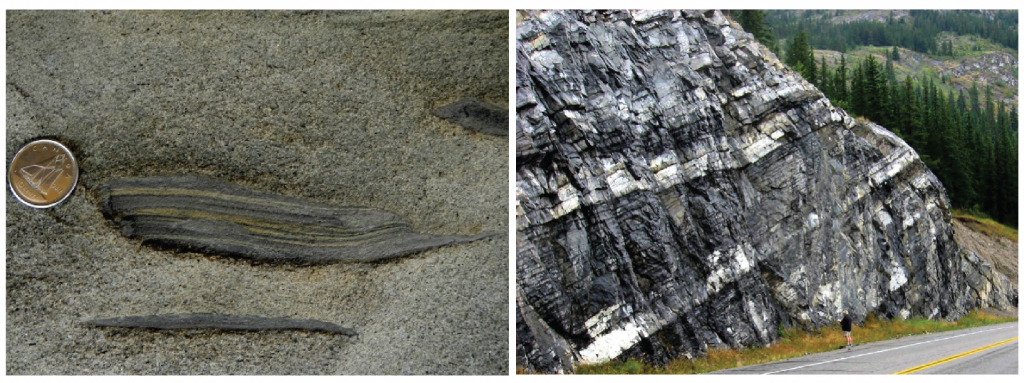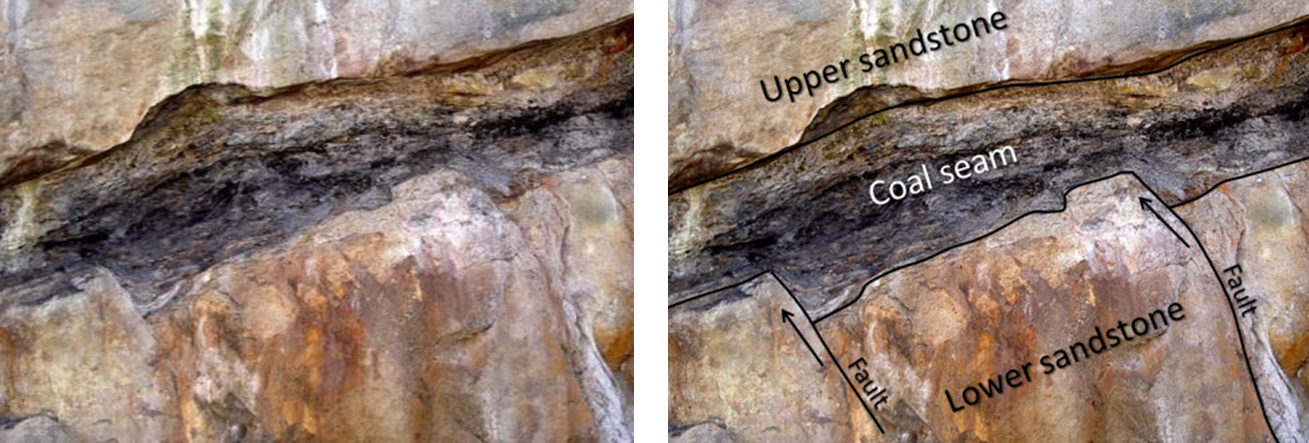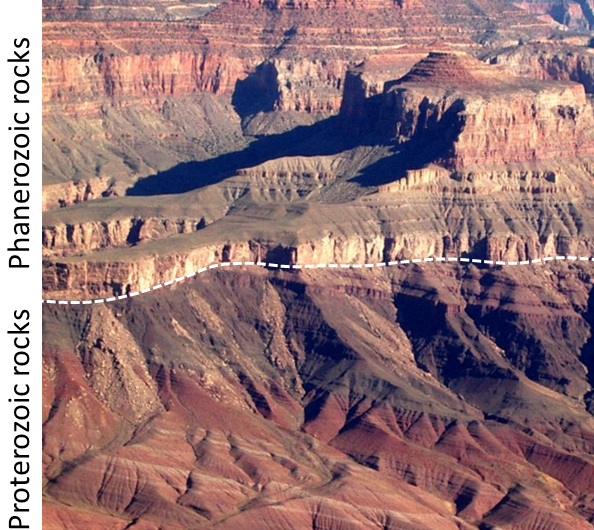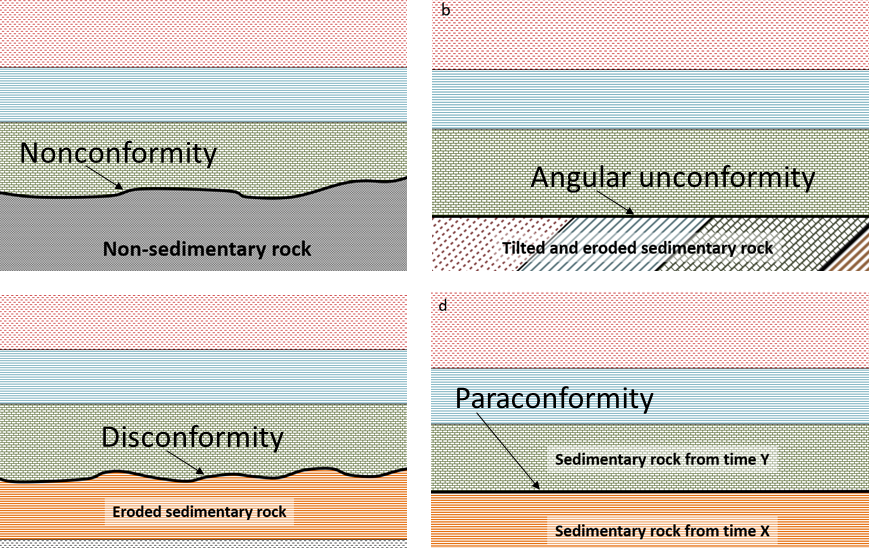7.2 Relative Dating Methods
There are two main ways in which geologists have built an understanding of geological time by dating geological materials: absolute dating and relative dating.
Absolute dating uses isotopic dating of rocks, or the minerals in them, based on the fact that we know the decay rates of certain unstable isotopes of elements and that these rates have been constant over geological time. It was only in the early part of the 20th century, when isotopic dating methods were first applied, that it became possible to discover the absolute ages of the rocks containing fossils. In most cases, we cannot use isotopic techniques to directly date fossils or the sedimentary rocks they are found in, but we can constrain their ages by dating igneous rocks that cut across sedimentary rocks, or volcanic layers that lie within sedimentary layers.
Relative dating, on the other hand, is the simplest and most intuitive way of dating geological features by examining the spatial relationships between them. There are a few simple rules for doing this, called the principles of stratigraphy. [1]
Through careful observation over the past few centuries, geologists have discovered that the accumulation of sediments and sedimentary rocks, as well as the eruption of some extrusive igneous rocks, takes place according to some important geological principles, as follows:
- The principle of original horizontality is that sediments accumulate in essentially horizontal layers, called beds. The implication is that tilted sedimentary beds observed to day must have been subjected to tectonic forces (Figure 7.2.1, right).
- The principle of superposition is that sedimentary layers are deposited in sequence, and that unless the entire sequence has been turned over by tectonic processes, the layers at the bottom are older than those at the top.
- The principle of inclusions is that any rock fragments in a sedimentary layer must be older than the layer. For example, the cobbles in a conglomerate must have been formed before the conglomerate was formed. Another example of this principle is shown in Figure 7.2.1 (left).
- The principle of faunal succession is that there is a well-defined order in which organisms have evolved through geological time, and therefore the identification of specific fossils in a rock can be used to determine its age. We won’t be covering fossils in any detail in this book as they are covered in the subsequent geology course (GEOL 1103), but they are extremely important for understanding sedimentary rocks. Of course, fossils can be used to date sedimentary rocks, but equally importantly, they tell us a great deal about the depositional environment of the sediments and the climate at the time. For example, they can help to differentiate marine versus terrestrial environments; estimate the depth of the water; detect the existence of currents; and estimate average temperature and precipitation.
- The principle of cross-cutting relationships is that a body or discontinuity that cuts across a stratum must have formed after that stratum. For example, a fault that cuts across sedimentary strata must be be younger than the strata. The analogy to remember is that of a sandwich: the sandwich must be made before it can be cut. The strata must exist before the fault can cut across them. An example of this is given in Figure 7.2.2, which shows three different sedimentary layers. The lower sandstone layer is disrupted by two faults, so we can conclude that the faults are younger than that layer. But the faults do not appear to continue into the coal seam, and they certainly do not continue into the upper sandstone. So we can infer that coal seam is younger than the faults (because it cuts them off), and of course the upper sandstone is youngest of all, because it lies on top of the coal seam.


Practice Exercise 7.1 Cross-Cutting Relationships

The outcrop shown here (at Horseshoe Bay, B.C.) has three main rock types:
- Buff/pink felsic intrusive igneous rock present as somewhat irregular masses trending from lower right to upper left
- Dark grey metamorphosed basalt
- A 50 centimetres wide light-grey felsic intrusive igneous dyke extending from the lower left to the middle right – offset in several places
Using the principle of cross-cutting relationships outlined above, determine the relative ages of these three rock types.
(The near-vertical stripes are blasting drill holes. The image is about 7 metres across.)
See Appendix 2 for Practice Exercise 7.1 answers.

One final important concept in the understanding of geologic time is the notion of missing segments of the rock record, recognized by unconformities. An unconformity represents an interruption in the process of deposition of sedimentary rocks. Recognizing unconformities is important for understanding time relationships in sedimentary sequences. An example of an unconformity is shown in Figure 7.2.4. The Proterozoic rocks of the Grand Canyon Group have been tilted and then eroded to a flat surface prior to deposition of the younger Paleozoic rocks. The difference in time between the youngest of the Proterozoic rocks and the oldest of the Paleozoic rocks is close to 300 million years. Tilting and erosion of the older rocks took place during this time, and if there was any deposition going on in this area, the evidence of it is now gone.
There are four types of unconformities, as summarized in Table 7.1, and illustrated in Figure 7.2.5.
| Unconformity Type | Description |
|---|---|
| Nonconformity | A boundary between non-sedimentary rocks (below) and sedimentary rocks (above) |
| Angular unconformity | A boundary between two sequences of sedimentary rocks where the underlying ones have been tilted (or folded) and eroded prior to the deposition of the younger ones (as in Figure 7.2.4) |
| Disconformity | A boundary between two sequences of sedimentary rocks where the underlying ones have been eroded (but not tilted) prior to the deposition of the younger ones |
| Paraconformity | A time gap in a sequence of sedimentary rocks that does not show up as an angular unconformity or a disconformity |

Key Takeaways
A common misconception when students think about unconformities is that an unconformity represents “missing time“. This is not the case: time continued to pass, it cannot be “missing“. What is “missing” is the record of this time in the stratigraphy of a given area, what geologists refer to as the rock record. For example, in the rock record of the southern plains of Alberta, the contact between the Jurassic Ellis Group and the Mississippian Rundle Group is an unconformity that represents over 150 million years! We can form two hypotheses to explain this missing section of the rock record in southeastern Alberta:
- No sediments were deposited in this area during that 150 million years, meaning that the unconformity represents a period of non-deposition, and/or
- Any sediments that were deposited during that 150 million years were eroded away before the deposition of the Ellis Group during the Jurassic, meaning that the unconformity represents a period of erosion.
Image Description
Figure 7.2.2 image description: The photograph shows three different sedimentary layers. The lower sandstone layer is disrupted by two faults, so we can conclude that the faults are younger than that layer. But the faults do not appear to continue into the coal seam, and they certainly do not continue into the upper sandstone. So we can infer that coal seam is younger than the faults (because it cuts them off), and of course the upper sandstone is youngest of all, because it lies on top of the coal seam.
Media Attributions
- Figures 7.2.1, 7.2.2, 7.2.3, 7.2.4, 7.2.5: © Steven Earle. CC BY.
- Stratigraphy is the branch of geology that deals with the formation, composition, sequence, and correlation of stratified rocks. Broadly speaking that includes all types of rock (igneous, sedimentary, and metamorphic), but often stratigraphers focus their studies on only sedimentary strata. ↵
the absolute dating (dating in years) of a geologic material using the decay of radio-isotopes within the material
an form of an element that differs from other forms because it has a different number of neutrons (e.g., 16O has 8 protons and 8 neutrons while 18O has 8 protons and 10 neutrons)
the interpretation of a relative order of events applied to a sequence of rocks using the principles of stratigraphy
a series of principles used to interpret strata (layers of rocks) and determine the geologic history of a given sequence of rocks
the principle that sedimentary beds are originally deposited in horizontal layers
The smallest formal lithostratigraphic unit of sedimentary rocks.
the principle that in a sequence of layered rocks that is not overturned or interrupted by faulting, the oldest will be at the bottom and the youngest at the top
the principle that inclusions within a body of rock must be older than the rock
the principle that life on Earth has evolved in an orderly way, and that we can expect to always find fossils of a specific type in rocks of a specific age
the principle that a body of rock that cuts across or through another body of rock is younger than that other body
layers of sedimentary, extrusive
igneous, metasedimentary, or metavolcanic rocks
a boundary in rock or sediment along which displacement has taken place
a geological boundary representing a period of erosion and/or non-deposition, where a portion of the rock record is missing
the surface that represents the boundary between two different bodies of rock.
The lithostratigraphic unit next higher in rank to formation; a stratigraphically-continuous series of related formations.

